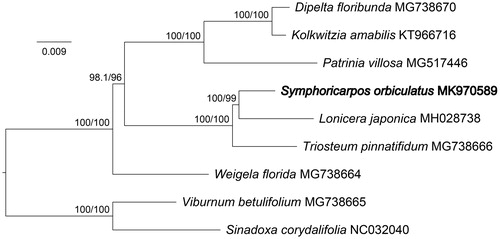Abstract
Symphoricarpos orbiculatus is an important landscape and ornamental plant. In this study, we report the complete chloroplast genome sequences of S. orbiculatus. The complete chloroplast genome of S. orbiculatus was 156,044 bp in length. The genome has a typical quadripartite structure, including a large single-copy (LSC) region of 88,756 bp, a small single-copy (SSC) region of 19,130 bp, and two inverted repeat (IR) regions of 24,079 bp each. Overall, the GC content was 38.4%. In the genome, it was identified to comprise130 genes, including 85 protein-coding genes, 37 tRNA genes, and 8 rRNA genes. This study provides valuable information for molecular phylogenetic study of Caprifoliaceae and is significant for variety development of Symphoricarpos.
Symphoricarpos is native to North America, Mexico and China. This genus, with many garden hybrids, has been more and more widely used in garden landscape for its ornamental value and high adaptability. The inherited characteristic study for Symphoricarpos is significant to the development of new varieties of this genus. Furthermore, it will provide valuable information for molecular phylogenetic study of Caprifoliaceae. Here, we assembled the complete chloroplast genome of Symphoricarpos orbiculatus and the annotated chloroplast genome sequence has been deposited in GenBank with Accession Number MK970589.
The fresh leaves of S. orbiculatus were collected from Shanghai Chen Shan Botanical Garden (N31°04′48.10″, E121°11′5.76″). Voucher specimen (collector and collection number: Xian-Yun Mu 3878) is deposited in the herbarium of Beijing Forestry University. Genomic DNA extraction and next-generation sequencing were performed with an Illumina Hiseq platform. In total, 14.4 Gb of 150-bp clean reads were generated and used for chloroplast genome assembly through Geneious 11.1.4 software (Kearse et al. Citation2012) with Lonicera japonica (Kang et al. Citation2018) as a reference sequence. The assembled chloroplast genome was then annotated using the Plann (Huang and Cronk Citation2015). Eventually, annotations were verified in Geneious 11.1.4 software.
The complete chloroplast genome of S. orbiculatus was 156,044 bp in length. The genome has a typical quadripartite structure, including a large single-copy (LSC) region of 88,756 bp, a small single-copy (SSC) region of 19,130 bp, and two inverted repeat (IR) regions of 24,079 bp each. Overall, the GC content was 38.4%. In the S. orbiculatus chloroplast genome, it was identified to comprise130 genes, including 85 protein-coding genes, 37 tRNA genes, and 8 rRNA genes.
S. orbiculatus and other 6 species from Caprifoliaceae, with 2 species from Adoxaceae as outgroup species, were used for phylogenetic analysis (). A total of nine complete chloroplast genomes were aligned using MAFFT (Katoh et al. Citation2017). Then, the maximum likelihood (ML) tree was constructed using IQ-TREE software (Kalyaanamoorthy et al. Citation2017; Hoang et al. Citation2018). The results indicated that S. orbiculatus, L. japonica and Triosteum pinnatifidum formed a monophyletic clade. Furthermore, there was a close relationship between S. orbiculatus and L. japonica.
Disclosure statement
The authors report no conflict of interest.
Additional information
Funding
References
- Hoang DT, Chernomor O, von Haeseler A, Minh BQ, Vinh LS. 2018. UFBoot2: Improving the ultrafast bootstrap approximation. Mol Biol Evol. 35:518–522.
- Huang DI, Cronk QC. 2015. Plann: A Command-line application for annotating plastome sequences. Appl Pl Sci. 3:1500026. v.
- Kalyaanamoorthy S, Minh BQ, Wong TKF, von Haeseler A, Jermiin LS. 2017. ModelFinder: fast model selection for accurate phylogenetic estimates. Nat Methods. 14:587–589.
- Kang S, Park H, Koo HJ, Park JY, Lee DY, Kang KB, Han SI, Sung SH, Yang T. 2018. The complete chloroplast genome sequence of Korean Lonicera japonica and intra-species diversity. Mitochondrial DNA Part B. 3:941–942.
- Katoh K, Rozewicki J, Yamada KD. 2017. MAFFT online service: multiple sequence alignment, interactive sequence choice and visualization: Brief Bioinform. In press.
- Kearse M, Moir R, Wilson A, Stones-Havas S, Cheung M, Sturrock S, Buxton S, Cooper A, Markowitz S, Duran C, et al. 2012. Geneious Basic: an integrated and extendable desktop software platform for the organization and analysis of sequence data. Bioinformatics. 28:1647–1649.

